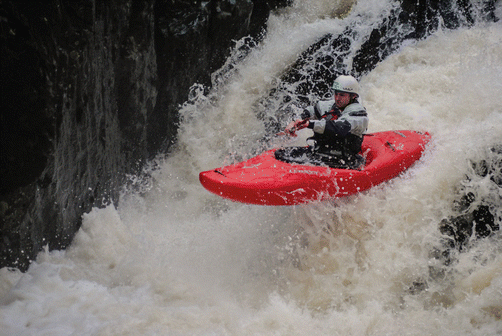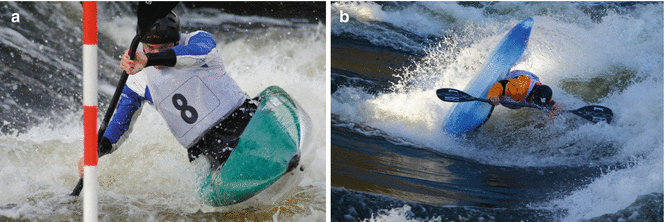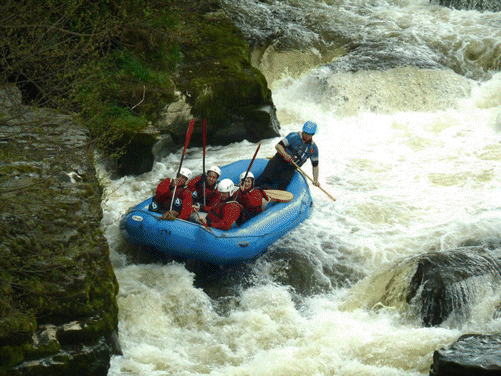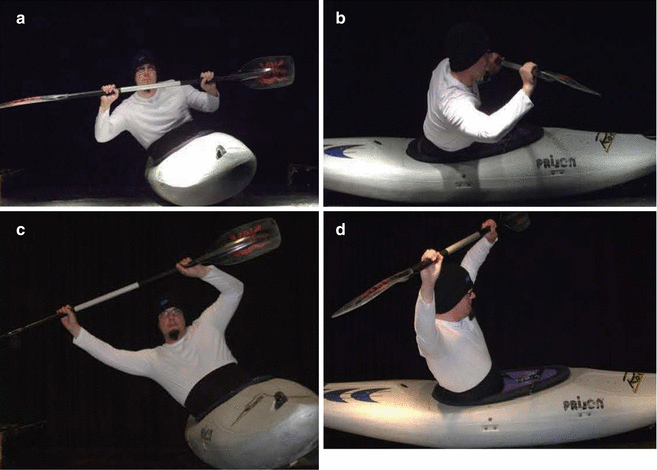Grade
Definition
I
Low-difficulty river where little training is needed. Flow is slow moving and predictable. Obstacles are unobtrusive and easily negotiated. Self-rescue is easy with little risk to the swimmer
II
Moderate difficulty river with faster flow. Rapids are straightforward and easy to negotiate with training. Rapids are small–medium sized and routes are clear and visible. Group-assisted rescue is beneficial but not required. Swimmers are rarely injured
III
Difficult river with fast flow. Rapids are irregular and can swamp or even hold craft. Complex manoeuvres may be required to negotiate rapids and obstacles. With training, hazards which may be present, such as large waves and strainers, can be avoided as routes are recognisable. Self-rescue is still possible, although to avoid long swims, assistance is required. Risk to health is still limited
IV
Very difficult, intense, powerful water. Rapids can be large and unavoidable, or steep and narrow, requiring precision to manoeuvre down the fast flow. Inspection before attempting is recommended, particularly for the first time. Hazards and obstacles are numerous, some below the surface, increasing the risk of injury to simmers. Practiced group rescue is often essential. A strong Eskimo roll, to avoid requiring rescue, is highly recommended
V
Extremely difficult river with long, obstructed and violent rapids. Characteristics include large drops, unavoidable waves and holes or steep, complex chutes which require high levels of precision and fitness from the paddler. Inspection is required but may be difficult. Swims are very dangerous, with a high risk of injury and even death. Rescue support is essential but may be difficult, even for experts
VI
High-risk rivers which are generally classed as un-runnable. High risk of injury to the participant. Requires scouting before attempting. This is for experts only. Portaging is highly recommended
With the development of man-made courses and easier access to rivers worldwide, participation has increased. White-water paddlesport participation statistics are not available worldwide; however, it is estimated that 1.9 million individuals participated in white-water kayaking in the USA during 2012 [3]. In addition to white-water kayaking, commercial white-water rafting is a popular recreational activity worldwide, which offers the opportunity for participants to experience white-water with limited previous experience. Approximately 3.7 million Americans participated in white-water rafting in 2012 [3].
Modern paddlesports involve a range of competitive and recreational activities. There are 11 competitive disciplines, involving a wide range of different craft, equipment and water conditions, each overseen by the International Canoe Federation (ICF) and International Rafting Federation (IRF). The white-water disciplines can be seen in Table 23.2. Canoe slalom, wild-water canoeing and canoe freestyle are the primary white-water disciplines. Other white-water disciplines include rafting and surf/waveski. Some canoe marathon and ocean racing (surfski) events involve white-water depending on the course or weather conditions; however, this is not the norm. White-water paddlesports are often performed for recreation and include activities such as playboating, white-water touring and river running. Some paddlers seek out the most extreme and challenging white-water by descending grade V and VI rapids. This can involve running waterfalls, first descents or seldom-navigated rivers (Fig. 23.1).


Table 23.2
Competitive white-water paddlesport disciplines
Discipline | Description |
|---|---|
Slalom (Fig. 23.2a) | A race where gates are negotiated down a course in the fastest possible time. Penalties are incurred for touching or missing gates in the course |
Freestyle (Fig. 23.2b) | Competitors complete various acrobats and manoeuvres on a single water hydraulic on a river. Points are scored for complexity and success of completion of manoeuvres |
Wild-water racing | Negotiating a stretch of river in the fastest possible time. Two main types include an endurance race and a sprint race |
Surf/waveski | Similar to freestyle where acrobatics and manoeuvres are completed; however, these are completed on ocean waves. Points are gained for the complexity and success of completing manoeuvres |
Raft racing | Rafts with either two (R2), 4 (R4) or 6 (R6) competitors per raft completing a series of three events. Scores from each event are taken to identify the overall winner. These events are (1) a slalom race, gates are negotiated down a course in the fastest possible time; (2) downriver race; an endurance race down a stretch of river; and (3) head-to-head sprit, two rafts competing head-to-head over a short stretch of river |

Fig. 23.1
A kayaker, recreationally negotiating quite extreme and very challenging white-water (Image © courtesy of Dale Mears)

Fig. 23.2
(a, b). Examples of competitive disciplines in white-water paddling. Image (a) is a kayak slalom paddler negotiating gates along the river. Image (b) is a freestyle kayaker performing acrobatic manoeuvres to score points (Images © courtesy of Dale Mears)
23.1.3 Craft, Equipment and Safety Recommendations
White-water can be negotiated in various craft of different shapes and sizes, depending on the purpose of the experience. Longer, narrow boats are designed for speed, particularly those with ‘V’-shaped hulls such as wild-water racers. Shorter crafts are more manoeuvrable and are appropriate when sudden changes in direction are desirable. The construction of paddlesport craft has evolved over time meaning that they are generally lighter and more robust. The evolution of robust recreational boats has facilitated the descent of waterfalls and previously ‘un-runnable’ rivers. Higher-grade white-water (III+) requires the craft to be either decked (watertight) or packed with air bags (inflatable bags that limit water entering the craft). However, inflatable and sit-on-top crafts which are increasing in popularity with novices on lower-grade rivers (I–II) and modern white-water rafts (Fig. 23.3) are self-bailing, meaning they drain and therefore do not flood with water.


Fig. 23.3
Examples of commercial white-water rafting. Image (a) is a raft negotiating a grade IV rapid, with all the clients safely inside the raft (Image © courtesy of Jon Best)
Choice of paddle design is dependent on paddling discipline, the physique and ability of the paddler. Longer paddles, with a greater blade area, are generally used where linear speed is important. In addition, greater feather angle (45–85°) and winged blades (‘spoon’ shaped with a distinct upper lip) are popular amongst those who race in kayaks. Some kayak paddlers use cranked shafts, which is suggested to improve performance and reduce injury risk, but this is not supported by empirical evidence. White-water rafters require longer paddles to reach the water. For higher-volume rivers, ores can be attached (typically with a metal frame) so the raft can be propelled by oars as well as paddles.
Preparation is critical. Appropriate equipment can mitigate the risk of some injury events or help manage situations that are already occurring (e.g. a capsize). It is recommended that the following items are essential for any paddling session:
Helmet – That is approved for use on white-water (e.g. CE EN 1985). Face guards are also advised on steeper, shallow rivers.
Personal floatation devices (PFDs) – That provide a minimum of 60 N of buoyancy (more is recommended for higher-grade and volume rivers) and should be white-water approved.
Clothing with the appropriate thermal properties – Mountain rivers are often cold (<5 °C) despite the temperature of the air. Clothing to keep warm/cool enough for the duration of the expedition is important. Wetsuits are popular with commercial white-water rafting providers because of the thermal properties, additional buoyancy and extra protection from impact injuries whilst ‘swimming’.
Throw bag – A bag of rope used to rescue swimmers. It can also be used to set up mechanical advantage systems.
River knife – A necessity, when carrying a rope, in case the rope becomes tangled and needs to be released quickly.
First-aid kit
Extensive information and training are available from many paddlesport organisations (clubs, federations, etc.). A summary of important safety information can be seen in Table 23.3.
Know your limits |
Be a competent swimmer in open water |
Have and use (where necessary) all the essential equipment: PFD or buoyancy aid, helmet, rescue equipment, etc. |
Know the river and weather conditions |
Have the appropriate clothing for the conditions |
Paddle in a group |
Do not paddle under the influence of drugs or alcohol |
Know how to deal with a capsize event |
23.1.3.1 White-Water Injuries and Ill Health
Accidents and injuries in white-water paddlesports are relatively rare, but due to the unpredictable environmental conditions associated with white-water sports, the consequences of accidents can be severe [5]. Injuries whilst submerged (including drowning, near drowning and impact traumas) are life threatening and account for approximately a third of white-water injuries [6]. Fortunately, fatal injuries are relatively rare. Drowning and submersion are the most common causes of fatal injuries [6, 7] and most often occur:
In inexperienced paddlers attempting rivers beyond their skill level
In adverse weather conditions
In high-water conditions
When appropriate safety equipments are not worn or used
Risk of fatalities increase as a result of entrapments, either foot or full body on strainers [8], blunt head trauma and symptoms of hypothermia (disorientation, loss of consciousness) linked to sudden immersion in cold water. This can further cause hyperventilation, bronchospasm and even cardiac arrest [9]. As the formal cause of death is not always available, it is unclear whether drowning is primary or secondary to another injury. This is particularly the case when fatal injuries are reported in the media.
Fatal injuries are extremely rare with a rate of 0.16–0.27 per 100,000 participants per annum for WW rafters [10] and a rate of 2.1 per 100,000 white white-water kayakers [11]. For all white-water paddlers, an injury rate of 0.86 per 100,000 user days has been observed [11] which is similar to trekking [12].
Survey data has estimated that per 1000 paddler days, 4.5 injuries occur amongst recreational canoeist and kayakers [13] and 5.2 injuries amongst competitive slalom canoeists and kayakers [14]. When compared to other outdoor adventure sports, the incidence of injury is similar to alpine skiing but higher than cross-country skiing or windsurfing [15, 16]. The injury incidence in commercial white-water rafters which required medical attention was estimated as 26.3 per 100,000 participants [17]. A much lower injury incidence of 1.04–1.81 per 100,000 participants required hospitalisation [10]. As with most sports, the incidence of white-water injuries rises with increased exposure [13] and is much higher during competition than training (ten times higher in competitive slalom paddlers [14]).
White-water injuries and ill health can be categorised as acute trauma injuries, chronic overuse injuries and environmental injuries and ill health. Most research has involved self-report data, as opposed to clinical or medical diagnoses. What literature there is has identified the upper body as most susceptible to injury for canoeists and kayakers. This is unsurprising as it is a predominantly an upper body sport. White-water rafters, who are in close proximity with others and are more likely to fall in the river, when compared to canoeists and kayakers, have a different pattern of injury. The facial region (33 %) and lower limbs, specifically the knees (15 %), are more at risk than the shoulders (6 %) [17].
Survey data has suggested that 42–51 % of all canoe/kayak injuries require medical attention [13, 18]. The shoulder is the most common site for severe injury in canoe/kayak paddlers. One study reported 14 % of all injuries were shoulder dislocations [18]; another survey reported that 15 % of international-level elite paddlers had experienced at least one shoulder dislocation [14]. In addition, more than half of elite slalom paddlers have reported a history of shoulder injuries [19].
Injuries sustained by white-water paddlers occur:
23.2 Acute Traumas
Acute traumatic injuries are the primary form of reported injuries, accounting for 58–62 % of all canoe/kayak injuries [13, 14]. Of acute injuries reported, the most common amongst canoe/kayak paddlers included sprain/strain (26 % of acute injuries), lacerations (17 %) and contusions (17 %) [13], and amongst competitive canoe/kayak paddlers, sprains (35 %) and tendonitis (20 %) were common [14]. A survey suggested that commercial white-water rafters experience similar acute injuries to canoe/kayak paddlers: lacerations (33 %), strains and sprains (23 %), fractures (23 %) and contusions/bruises (10 %) [17].
23.2.1 In Boat
In-boat injuries sustained by canoe/kayak paddlers tend to be in the upper body, as this is the most exposed and therefore vulnerable part of the body [8, 13, 14, 18]. Sudden internal or external forces on the body may overload a muscle group or joint resulting in muscle strain or joint sprain injuries, for example, forceful paddle strokes to make an eddy or an attempt to stay upright with a powerful support stroke. The shoulder and lower back are susceptible to strain/sprain injuries. Lacerations, contusions, abrasions and fractures to any exposed region of the body are common as a result of collisions with rocks [13]. This could be whilst upright or upside down prior to completing an Eskimo roll (a method of righting oneself following being upturned on a river) [8]. Collision injuries are the most common form of injury amongst rafters [17]. This is from colliding with other rafters (those in the middle of the raft are most at risk), especially if they are holding their paddle incorrectly, allowing the loose end to swing into others on the raft. Consequently, facial lacerations, contusions, abrasions and dental damage are common rafting injuries [17]. Lower extremity injuries can also occur whilst in boat. For example, rafters can entrap a foot in the gutter of the raft whilst being thrown out of their seat resulting in knee and ankle damage [8]. Paddling a kayak head-on into an obstacle causes a sudden deceleration that can sprain the ankles [8].
As previously mentioned, shoulder dislocations are not uncommon, e.g. 15 % of respondents of one survey had reported having at least one [14]. This is a severe injury, which typically requires several weeks of immobilisation and a prolonged absence from paddling. Strenuous high brace supports to avoid capsizing have been associated with the anterior displacement of the humeral head, resulting in either a dislocation or subluxation. Poor high brace technique is widely considered to make the shoulder vulnerable to dislocation (Fig. 23.4). A combination of shoulder abduction with external rotation and extension can lever the humeral head out of the glenoid fossa. Extension of the elbow also increases the force transmitted along the arm, increasing the risk of wrenching the humeral head out of the glenoid fossa. Good practice for a high brace involves reducing the abduction and external rotation of the shoulder, the elbow lower and further forwards than the shoulder, the hand in front of the elbow and the elbow flexed. It has been suggested that female paddlers, who generally have less muscle mass to help stabilise the shoulder, are at greater risk of shoulder dislocations [7]; however, there is little empirical evidence to support this claim.


Fig. 23.4
Good high brace technique (a, b) and poor high brace technique (c, d) with regard to the risk of shoulder dislocation
Other extreme injuries may occur on grade V and grade VI descents and waterfall jumping. Although there are no scientific reports of these injuries, there are numerous anecdotal reports and online databases (e.g. American Whitewater) which provide some insight into such incidents. For kayak paddlers, descending waterfalls involves an inherent risk of spinal damage, including vertebral compression fractures, from the high-impact forces experienced on landing, especially if the boat lands flat [20]. Such injuries may cause paralysis. Other potential impact injuries include long bone and pelvic fractures, abdominal/chest trauma and head injuries. It is therefore important to have the relevant rescue and medical support teams available on site when attempting waterfall descents.
23.2.2 Swimming
Turbulent water can cause craft to be unstable, resulting in a capsize and the paddler ‘falling out’ of their craft. In the event of swimming, it is important for the paddler to stay close to their craft as this provides an excellent flotation aid. In the event of ‘falling out’ of a raft, holding on to the perimeter rope whilst twisting and falling may cause contusions and abrasions on the hands, specifically around the fingers and fingernails. If the water is particularly powerful, holding on to the raft may be damaging as it puts a lot of pressure on the wrist, elbow and shoulder joints. In this situation, there is a risk of sprains.
Swimming in turbulent water is a highly unpredictable situation, where the swimmer has limited control and consequently there is a significant risk of impact with rocks and other obstacles. Frequent injuries to the lower extremities include lacerations, contusions, abrasions and fractures [10, 13, 17]. Although the lower extremities are at higher risk of injury, other regions of the body are also at risk [8]. It is recommended that swimmers adopt a defensive swimming position to avoid submerged obstacles. If defensive swimming is not adopted, the risk of entrapment will increase. Entrapments are rare but serious and tend to happen in shallower rivers (waist deep) or in flooded rivers where other obstacles become submerged (e.g. trees, fences) creating additional hazards. The most common form is a foot entrapment; this is where the foot or ankle is trapped by an obstacle such as a tree root or between two rocks. The force of the water can make it very difficult to dislodge the entrapped body part and a rescue may be required. Even minor entrapments typically causing abrasions and contusions with sprains and fractures are also possible. In extreme cases where the force of the water is great, drowning is a likely outcome. Entrapments are very serious and the victim needs to be rescued as quickly as possible from the situation. The severity of the accident will increase with time taken to rescue the individual.
23.2.3 On Land
Trekking to and from a river, portaging around rapids or performing a land-based rescue all increase the risk of ankle sprains, foot injuries and falls amongst paddlers. The uneven surface of a river bank is often slippery and unstable making these situations potentially hazardous, particularly when carrying a boat and/or other equipment. Robust footwear with good grip is highly recommended but not typically worn by paddlers.
Stay updated, free articles. Join our Telegram channel

Full access? Get Clinical Tree








